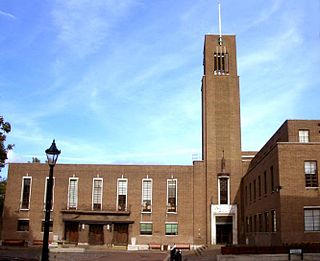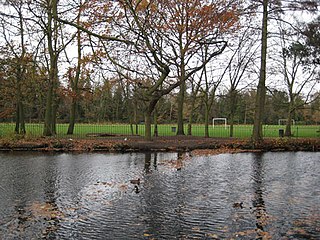
The London Borough of Southwark in south London forms part of Inner London and is connected by bridges across the River Thames to the City of London and London Borough of Tower Hamlets. It was created in 1965 when three smaller council areas amalgamated under the London Government Act 1963. All districts of the area are within the London postal district. It is governed by Southwark London Borough Council.

Crystal Palace is an area in south London, England, named after the Crystal Palace Exhibition building, which stood in the area from 1854 until it was destroyed by fire in 1936. Approximately 7 miles (11 km) south-east of Charing Cross, it includes one of the highest points in London, at 367 feet (112 m), offering views over the capital. The area has no defined boundaries and straddles five London boroughs and three postal districts, although there is a Crystal Palace electoral ward and Crystal Palace Park in the London Borough of Bromley. It forms a part of the greater area known as Upper Norwood, and is contiguous with the areas of Anerley, Dulwich Wood, Gipsy Hill, Penge, South Norwood and Sydenham.

Dulwich is an area in south London, England. The settlement is mostly in the London Borough of Southwark, with parts in the London Borough of Lambeth, and consists of Dulwich Village, East Dulwich, West Dulwich, and the Southwark half of Herne Hill. Dulwich lies in a valley between the neighbouring districts of Camberwell, Crystal Palace, Denmark Hill, Forest Hill, Peckham, Sydenham Hill, and Tulse Hill.

Sydenham is a district of south-east London, England, which is shared between the London boroughs of Lewisham, Bromley and Southwark. Prior to the creation of the County of London in 1889, Sydenham was located in Kent, bordering Surrey. Historically, the area was very affluent, with the Crystal Palace being relocated to Sydenham Hill in 1854. Today, Sydenham is a diverse area, with a population of 28,378 and borders Forest Hill, Dulwich, Crystal Palace, Penge, Beckenham, Catford and Bellingham.

East Dulwich is an area of South East London, England in the London Borough of Southwark. It forms the eastern part of Dulwich, with Peckham to the east and Camberwell to the north. This South London suburb was first developed in the nineteenth century on land owned by the College of God's Gift.

Hornsey Town Hall is a public building in Hatherley Gardens in the Crouch End area of Hornsey, London. The building was used by the Municipal Borough of Hornsey as its headquarters until 1966. It is a Grade II* listed building.

Lordship Lane is an ancient thoroughfare, once rural, in East Dulwich, a suburb of the London Borough of Southwark in southeast London, England, and forms part of the A2216.

The London Borough of Southwark, occupying a roughly triangular area south of Tower Bridge over the River Thames, considers itself to be one of the greenest boroughs in London, with its 245 hectares of public parkland. There are more than 130 such green areas, ranging from the large areas around Dulwich and Southwark Park in Rotherhithe to the many sports grounds and squares. The main ones are:

Berthold Romanovich Lubetkin was a Georgian-British architect who pioneered modernist design in Britain in the 1930s. His work includes the Highpoint housing complex, the Penguin Pool at London Zoo, Finsbury Health Centre and Spa Green Estate.
Dulwich was a borough constituency in the Dulwich area of South London, which returned one Member of Parliament (MP) to the House of Commons of the Parliament of the United Kingdom.

Gipsy Hill in south London is a hilly neighbourhood spanning the southern parts of the London Boroughs of Lambeth and Southwark characterised for its great views of the City of London and Dulwich.

West Dulwich is a district in South London, which straddles the London Borough of Lambeth and the London Borough of Southwark. Croxted Road and South Croxted Road mark the boundary between Southwark to the east and Lambeth to the west. The suburb of West Dulwich dates back to the 17th century when the often flooded land known as Dulwich Common was acquired and drained by Edward Alleyn's estate.

Dulwich Wood, together with the adjacent Sydenham Hill Wood, is the largest extant part of the ancient Great North Wood in the London Borough of Southwark. The two woods were separated after the relocation of The Crystal Palace in 1854 and the creation of the high level line in 1865. The wood is privately owned and managed by the Dulwich Estate.

Sydenham Hill forms part of a longer ridge and is an affluent locality in southeast London. It is also the name of a road which runs along the northeastern part of the ridge, demarcating the London Boroughs of Southwark, Bromley, and Lewisham. Its highest part is the apex of the Boroughs of Southwark and Lewisham and the 15th-highest peak in London, at 367 feet (112 m).

The Tecton Group was a radical architectural group co-founded by Berthold Lubetkin, Francis Skinner, Denys Lasdun, Michael Dugdale, Anthony Chitty, Val Harding, Godfrey Samuel, and Lindsay Drake in 1932 and disbanded in 1939. The group was one of the leaders in bringing continental modernism to Britain.

Belair Park is a park located in the West Dulwich part of the London Borough of Southwark, southeast London, England. The park grounds once belonged to Belair House, a country villa built in Adam style that is now a Grade II listed building. There are also two other Grade II listed structures within the park: the lodge and entrance gate, and an old stable building.

Sydenham Hill Wood is a ten-hectare wood on the northern slopes of the Norwood Ridge in the London Borough of Southwark. It is designated as a Local Nature Reserve and Site of Metropolitan Importance for Nature Conservation. With the adjacent Dulwich Wood, Sydenham Hill Wood is the largest extant tract of the ancient Great North Wood. The two woods are formed from coppices known as Lapsewood, Old Ambrook Hill Wood and Peckarmans Wood after the relocation of The Crystal Palace in 1854 and the creation of the high level line in 1865.

Beltwood House is a Grade II listed building within the Dulwich Wood Conservation Area in south London, England. The large three-storey mansion has fifty rooms and stands in 1.24 hectares of wooded grounds, with gatekeeper's lodge. The site has been subject to a blanket tree preservation order since 1985.

Dulwich Community Hospital was a hospital located in Dulwich, London. It was replaced by a modern health centre on the same site in April 2020.

St Olaf House is a Grade II* listed building on Tooley Street in the London Borough of Southwark. The house was built on the site of St Olave's Church, Southwark between 1928 and 1932, and is now part of London Bridge Hospital.




















